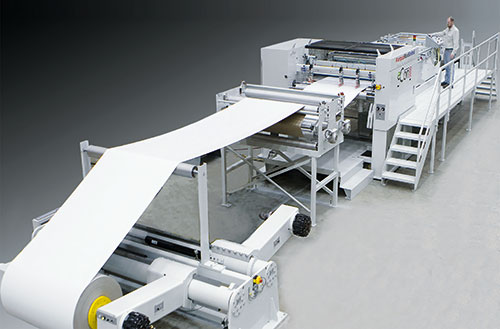
When converting paper and cardboard rolls to sheets in various formats, high demands are placed on sheet and stack quality. BW Papersystems relied on PC-based control for the development of the eCon folio-size sheeter. This has greatly reduced costs compared to the legacy system and increased simplicity from commissioning to operation. The resulting machine meets the requirements of smaller end-user companies in the printing and packaging industry.

With more than 50 years of experience as a provider of paper, paperboard and cardboard cutting and packaging machinery, BW Papersystems maintains its global headquarters in Phillips, Wisconsin, with additional manufacturing plants in Germany, Italy, Hungary and China. The company’s folio sheeter systems are used for converting massive reels of paper and paperboard at high speed to folio-size sheets. In order to enable trouble-free processing in downstream printing and packaging applications, various prerequisites must be fulfilled. “A key feature of our products is sheet and stack quality,” says Jeff Gafner, senior vice president of engineering and service for BW Papersystems. “These criteria include edge quality and minimal dust and debris, which lead to more downtime due to frequent printer cleaning. Dimensional consistency and stack quality permit the highest possible feed rates with minimal jamming.”
Apart from that, BW Papersystems had an aggressive goal when designing the eCon folio sheeter: The machine needed to cost 50% less than the legacy system it would replace. This way it could meet the requirements of companies with a smaller investment budget in the highly competitive printing and paper industry. “The intention of this US-built machine was to provide industry-leading sheet and stack quality at a price that’s competitive with imported machines,” explains Gafner.
Simplicity in application and support
Apart from meeting the cost reduction goals with Beckhoff technology, it was also important to create a design that showcased innovation and simplicity. According to Erik Paulson, project engineer for BW Papersystems: “Simplicity in terms of electrical design includes connectivity between the different components and the eventual replacement of components in the field. It also includes the ease of machine startup, such as downloading drive parameters once drives have been installed or replaced.”
The concern for simplicity also extended to simple user interfaces. It was realised with the intuitive Beckhoff CP2907 multi-touch control panel displaying the HTML5-capable HMI, which supports remote access to the TwinCAT control system of the eCon Sheeter. In this way, even smaller companies are able to troubleshoot equipment on site and can avoid costly downtime, without service engineers having to travel to the factory. In addition, TwinCAT 3 automation software not only supports remote access, but also includes indispensable diagnostic tools, including Scope View. “We have the ability to monitor a multitude of signals, even in the 250-microsecond range, and display them using TwinCAT Scope View,” Paulson says. “We use Scope View frequently to troubleshoot problems or simply to tune the system, and I believe it is one of the biggest selling points of the TwinCAT software platform.”
From running the PLC to handling motion control and the HMI, a CX2020 embedded PC automates the entire machine. According to BW Papersystems, this is a great improvement from previous machines that required hardware PLCs for each function.
The EtherCAT terminal system from Beckhoff proved to be a great space saver, and EtherCAT enabled the system to communicate in real time and provide extremely fast servo loops. TwinSAFE terminals integrated throughout the system architecture allow the eCon machine to operate large rollers and high-speed cutters and ensure functional safety by monitoring all hazard points.
Cutting cost and cabinet size in half
Compact EtherCAT I/O helped reduce the control cabinet size by 50% for some units and closer to 70% for others. The space-saving CX2020 embedded PC also allows the machine to run a 30 000-line count encoder, which is a functional improvement over the legacy system. Combined with high-performance EtherCAT servo drives, TwinSAFE technology and the intuitive multi-touch HMI, the end result offers simplicity without sacrificing innovation for end users. On top of that, the eCon Sheeter also simplifies commissioning by reducing installation times by 65%.
| Tel: | +27 11 795 2898 |
| Email: | [email protected] |
| www: | www.beckhoff.com |
| Articles: | More information and articles about Beckhoff Automation |

© Technews Publishing (Pty) Ltd | All Rights Reserved